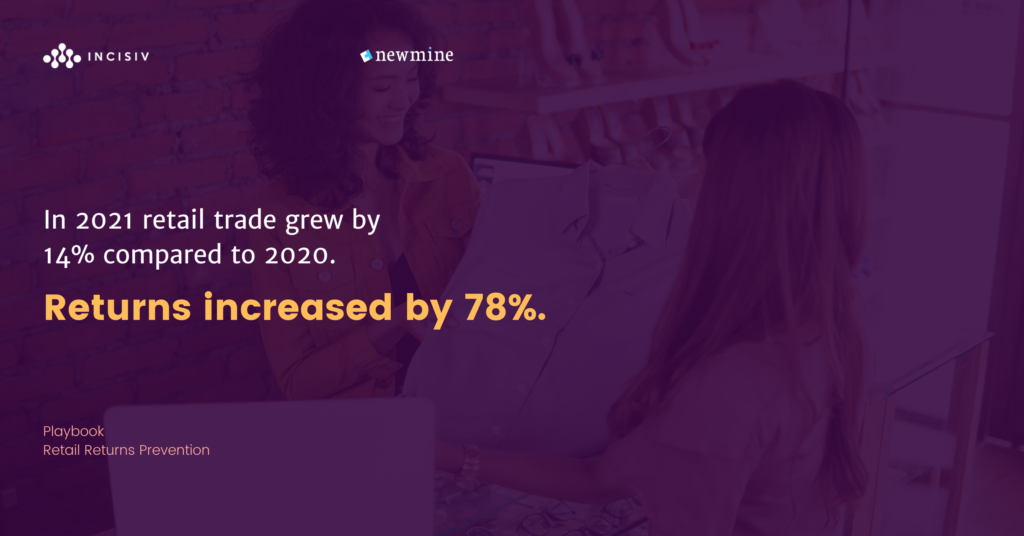According to the National Retail Federation (NRF), retail sales grew by 14% in 2021 over 2020. However, the headline should have been that retail returns grew by a staggering 78% (according to the same data NRF publishes, returns totaled $428 billion in 2020 and $761 billion in 2021).

And, a convergence of forces means returns are set to become an even more important consideration for retailers and brands.
- A digital-first world order: Typically, shoppers return online purchases three to four times more than they do store-bought purchases. As shoppers buy more things online, they will also return more things.
- A sustainable future: Europe already requires climate reporting for certain public companies, and the US is likely to adopt similar measures over the next few years. ESG (environmental, social, governance) investors are pushing hard for climate risk to be incorporated into firm valuation.
- A slippery slope of customer churn: It has never been more expensive to acquire new customers, and never easier to lose loyal ones. Returns are a major trigger for customer churn; 42% of shoppers will stop shopping a retailer upon multiple retailer-induced returns.
Returns are a double-edged sword for retailers. On the one hand, they represent the very idea of shopper-friendly convenience that is the bedrock of American consumer-first capitalism. On the other, returns represent lost revenue, an increase in cost (e.g. handling costs, reverse logistics and inventory carrying costs), a strain on the environment and a less than ideal customer experience.
Retailers must embrace this duality of returns rather than ignore it. According to Incisiv and Newmine’s State of the Industry: Retail Returns study, 80% retailers factor baseline return rates into their merchandise planning process. And 75% retailers prioritize having a good returns experience over reducing returns.
So, how do we change the status quo? The answer may lie in a revealing insight from the same Incisiv and Newmine study – 73% of returns occur due to a retailer controllable action. These include instances where the product quality was not as expected, the color did not match the product description, a wrong item was sent, the product arrived damaged, the product arrived later than expected, there were issues with product fit, and so on.

McKinsey & Company highlights identifying the root cause of returns as one of the first steps retailers must take to reduce returns. Yet, according to our research, 7 in 10 retailers do not have a good understanding of the root cause of their returns.
Retailers can’t (and shouldn’t) eliminate returns, but they can (and must) reduce them. A simplified takeaway would be for retailers to do both: improve internal processes to reduce the operational anomalies and errors that lead to preventable returns, and offer shoppers a best-in-class returns experience.
It is for this reason Incisiv and Newmine launched the Retail Returns Reduction Playbook – a structured perspective to help retailers and brands get started on the journey of reducing controllable returns.

The business case for preventing retail returns
MIT Sloan Management Review published Managing Product Returns for Competitive Advantage in 2006. It is surprising that 16 years later, 97% of retailers do not have an identified executive owner responsible for reducing returns.
Retailers must establish a strategic initiative focused on returns optimization. The lack of executive ownership on this issue is one of the biggest hurdles they face.
To help retailers get started on such a strategic initiative, here’s a wireframe for defining business value:
Increase enterprise value
- Protect revenue by reducing sales lost to returns
- Enhance performance across multiple ESG vectors
- Improve brand value by reducing bad experiences
Improve profitability
- Reduce cost of processing returns
- Reduce cost of returns experience management
- Improve operational performance across categories, products and suppliers
Enhance experience
- Reduce post-purchase shopper dissatisfaction
- Convert return transactions into engagements
- Personalize return experiences based on shopper behavior
Even if retailers focus on just one dimension of enterprise value – revenue protection – the business impact is apparent. Consider illustrative examples of two retailers below. If each of them were to reduce controllable returns by just 15%:
- A large specialty retailer with $10 billion in annual revenue and a best-in-class blended return rate of 10% would add $109 million to its top-line.
- A mid-size apparel retailer with $500 million in annual revenue and an industry average blended return rate of 35% would add $19 million to its top-line.
Each would also realize significant gains in profitability, sustainability, customer experience and brand value.
As retailers review their returns reduction opportunity, these simplified examples help illustrate that value exploration should be driven by total business impact potential, not whether they have a high or low return rate.
Over the next five years, preventative strategies that reduce controllable returns and optimize return rates across products, suppliers and categories will become a key part of retailers’ strategic toolkit to drive sustainable growth.
Giri Agarwal is co-founder & chief strategy officer at Incisiv, a consumer and technology industry observer, and an entrepreneur. Navjit Bhasin is founder & CEO of Newmine and is a visionary expert in strategy, technology, operations, and change management.
Subscribe to SmartBrief’s free newsletter to get the latest marketing news and insights direct to your inbox.
